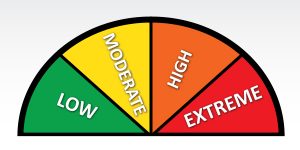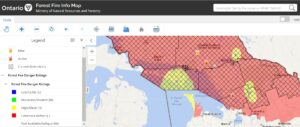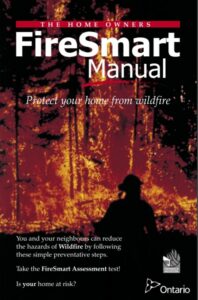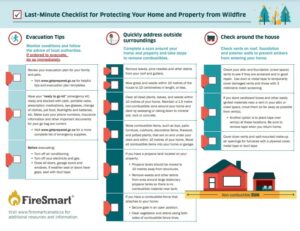How Fire Risk Is Determined
 Fuel, wind and an ignition source are the recipe for wildfires. Forecasters rely on the Canadian Forest Fire Danger Rating System (CFFDRS) which assesses the fuel available based on past and present weather conditions. Larger fuel like logs can take months to change significantly whereas the availability and conditions of small fuel like leaves and branches can change rapidly so it is important to check the rating frequently and know that a little bit of rainfall might not significantly reduce wildfire risk.
Fuel, wind and an ignition source are the recipe for wildfires. Forecasters rely on the Canadian Forest Fire Danger Rating System (CFFDRS) which assesses the fuel available based on past and present weather conditions. Larger fuel like logs can take months to change significantly whereas the availability and conditions of small fuel like leaves and branches can change rapidly so it is important to check the rating frequently and know that a little bit of rainfall might not significantly reduce wildfire risk.
The danger rating also takes into account how difficult it will be to put out any fires that do start. Forecasters refer to the 30-30-30 Crossover Rule, which maintains that if a wildfire starts while the temperature is 30C or above, the relative humidity is 30% or less and the wind speed is 30km/h or stronger, it will exhibit extreme fire behaviour and be difficult to control until weather conditions change.
Ignition is where heeding the fire danger ratings can make a big difference. Experts estimate that half of all wildfires are started by lightning strikes, but the other half are started by people. By paying attention to the local conditions and following the guidelines for acceptable burning in your area, you can significantly cut the risk of ignition.

Grid pattern shows the current RFZ
Ontario currently has a Ontario has already issued restricted fire zones (RFZs), which ban virtually all outdoor fires, even those for cooking or warmth. If an RFZ is broken, the province can hold the person responsible for all costs to fight a resulting fire, plus a fine of up to $25,000 and three months in jail. Municipalities can also have their own fines and penalties for local violations.
What to do When Fire Danger is Extreme
 Safety is always key when the fire danger rating is high or extreme in your area and there are things you can do to help mitigate risk to yourself and your property. MNRF through their FireSmart Program have developed some great resources, ideas and preventative measures you can take to reduce the risk. The FireSmart manual for your home can be found here.
Safety is always key when the fire danger rating is high or extreme in your area and there are things you can do to help mitigate risk to yourself and your property. MNRF through their FireSmart Program have developed some great resources, ideas and preventative measures you can take to reduce the risk. The FireSmart manual for your home can be found here.
The following videos also offer some quick tips to prepare your property:
 It is crucial to have a fire safety plan and make sure all family members know what to do if a fire were to start close to your community. Having a well practiced plan is one of the best ways to ensure your safety in an emergency situation.
It is crucial to have a fire safety plan and make sure all family members know what to do if a fire were to start close to your community. Having a well practiced plan is one of the best ways to ensure your safety in an emergency situation.
In the event an evacuation is necessary, the FireSmart Wildfire Evacuation Checklist has a list of steps you can take on your way out to secure and protect your property.
GBA Weekly Fire Danger Rating Report
To provide you with the most up-to-date overview, GBA issues a Fire Danger Rating Report every Thursday for the summer season. This report is an amalgamation of the current information with links to the Ministry of Natural Resources and Forestry (MNRF) and your local municipalities. See the latest Fire Danger Ratings Report here.
GBA has other great fire prevention resources here.
